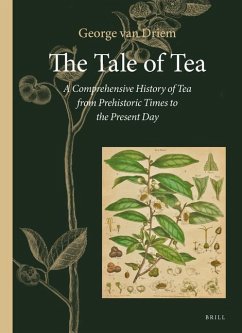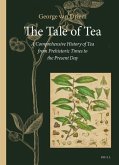George L. van Driem
The Tale of Tea
A Comprehensive History of Tea from Prehistoric Times to the Present Day
George L. van Driem
The Tale of Tea
A Comprehensive History of Tea from Prehistoric Times to the Present Day
- Gebundenes Buch
- Merkliste
- Auf die Merkliste
- Bewerten Bewerten
- Teilen
- Produkt teilen
- Produkterinnerung
- Produkterinnerung
The Tale of Tea is the saga of globalisation. Tea gave birth to paper money, the Opium Wars and Hong Kong, triggered the Anglo-Dutch wars and the American war of independence, shaped the economies and military history of Táng and Sòng China and moulded Chinese art and culture. Whilst black tea dominates the global market today, such tea is a recent invention. No tea plantations existed in the world's largest black tea producing countries, India, Kenya and Sri Lanka, when the Dutch and the English went to war about tea in the 17th century. This book replaces popular myths about tea with…mehr
Andere Kunden interessierten sich auch für
![The Tale of Tea The Tale of Tea]() George L. van DriemThe Tale of Tea108,99 €
George L. van DriemThe Tale of Tea108,99 €![Treasure Trove of Benefits and Variety at the Table Treasure Trove of Benefits and Variety at the Table]() Treasure Trove of Benefits and Variety at the Table166,99 €
Treasure Trove of Benefits and Variety at the Table166,99 €![Best of Delectable Foods and Dishes from al-Andalus and al-Maghrib Best of Delectable Foods and Dishes from al-Andalus and al-Maghrib]() Nawal NasrallahBest of Delectable Foods and Dishes from al-Andalus and al-Maghrib179,99 €
Nawal NasrallahBest of Delectable Foods and Dishes from al-Andalus and al-Maghrib179,99 €![Perak and the Malays Perak and the Malays]() John Frederick Adolphus McNairPerak and the Malays31,90 €
John Frederick Adolphus McNairPerak and the Malays31,90 €![Chinese Émigré Intellectuals and Their Quest for Liberal Values in the Cold War, 1949-1969 Chinese Émigré Intellectuals and Their Quest for Liberal Values in the Cold War, 1949-1969]() Kenneth Kai-Chung YungChinese Émigré Intellectuals and Their Quest for Liberal Values in the Cold War, 1949-1969147,99 €
Kenneth Kai-Chung YungChinese Émigré Intellectuals and Their Quest for Liberal Values in the Cold War, 1949-1969147,99 €![Coping with the Future Coping with the Future]() Coping with the Future166,99 €
Coping with the Future166,99 €![The Light of Asia The Light of Asia]() Christopher HardingThe Light of Asia9,99 €
Christopher HardingThe Light of Asia9,99 €-
-
-
The Tale of Tea is the saga of globalisation. Tea gave birth to paper money, the Opium Wars and Hong Kong, triggered the Anglo-Dutch wars and the American war of independence, shaped the economies and military history of Táng and Sòng China and moulded Chinese art and culture. Whilst black tea dominates the global market today, such tea is a recent invention. No tea plantations existed in the world's largest black tea producing countries, India, Kenya and Sri Lanka, when the Dutch and the English went to war about tea in the 17th century. This book replaces popular myths about tea with recondite knowledge on the hidden origins and detailed history of today's globalised beverage in its many modern guises.
Produktdetails
- Produktdetails
- Verlag: Brill
- Seitenzahl: 924
- Erscheinungstermin: 1. März 2019
- Englisch
- Abmessung: 267mm x 213mm x 55mm
- Gewicht: 2844g
- ISBN-13: 9789004386259
- ISBN-10: 9004386254
- Artikelnr.: 54619009
- Herstellerkennzeichnung
- Libri GmbH
- Europaallee 1
- 36244 Bad Hersfeld
- gpsr@libri.de
- Verlag: Brill
- Seitenzahl: 924
- Erscheinungstermin: 1. März 2019
- Englisch
- Abmessung: 267mm x 213mm x 55mm
- Gewicht: 2844g
- ISBN-13: 9789004386259
- ISBN-10: 9004386254
- Artikelnr.: 54619009
- Herstellerkennzeichnung
- Libri GmbH
- Europaallee 1
- 36244 Bad Hersfeld
- gpsr@libri.de
George van Driem directs the Linguistics Institute at the University of Bern, where he occupies the Chair of Historical Linguistics. He has written grammars of Limbu, Dzongkha, Bumthang and Dumi and authored the two-volume ethnolinguistic handbook Languages of the Himalayas (Brill, 2001).
Preface
1 The Primordial Origins of TeaA Brief Ethnolinguistic PreambleVarieties of Tea Tree and Some Close RelativesThe Original Tea Emerges from the Mists of TimeAn Ancient Trans-Himalayan Root Denoting TeaAn Ancient Austroasiatic Root Denoting TeaFermented Eatable Tea Becomes Fermented Drinkable TeaOld and New Tea Etyma in the Original Tea Homeland
2 Tea Spreads to ChinaShrouded behind the Veil of WritingThe Chinese Characters tú and chá From the Hàn Dynasty to the Suí DynastyTea Becomes Fashionable in the TángA Tea Sage Is Discovered under a Stone BridgeThe Tea Sage Becomes a ManLù Y s Tea Treatise and His Old AgeTea and the Water with Which It Is MadeThe Blossoming of Tea Culture and PorcelainTibet Takes to Tea in the TángTea Is Taxed by the TángThe Sòng under SiegeThe Sophistication of the SòngChinese Tea Culture Blossoms Anew in the MíngA ilha formosaThe Manchu and the Colours of the Chinese RainbowChinese Green TeasWhite Teas and Albino CultivarsChinese Yellow TeasBlue Teas, Swarthy Dragon and Rock TeasChinese Red TeasChinese Fermented or Dark TeasScented Teas, Herbal Infusions, Punch and Cocktails
3 Tea Arrives in Japan and KoreaTea Comes to the Land of the Rising SunTea Comes to Japan yet AgainBuddhist Monastery Tea RitualsTea Tasting Competitions and Bawdy BazaarsN ami Takes Tea from the Tea Pavilion into a Domestic SettingAn Oasis of Calm in a Troubled TimeJ Picks up Where Juk Left OffSen no Riky Tea Schools Arising through the Seven DisciplesTea Schools through Family DescentThe Tea Ceremony FossilisesThe Manufacture of matcha and tenchaJapanese Parched Green Tea or kamairi chaSencha, shincha and banchaKabusecha, Gyokuro and the Flavour UmamiMiscellaneous Other Types of Japanese TeaJapanese Tea Culture Travels AbroadJapanese Tea Cultivars and Tea ProductionInnovations and Nostalgic Retentions in Japanese TeaA Non-Japanese Drink with a Japanese NameTea Reaches the Korean PeninsulaThe Renaissance of Korean Tea
4 East Meets West: the Intrepid PortugueseGetting into Hot WaterTea by way of the Silk RouteSetting Sail for CipanguA Surprise WelcomeSilk and Silver Rather Than TeaUma chávena de cháThe Tea Ceremony, Oolong Tea and Saying MassMore Reports of the Tea CeremonyRicci and RodriguesJewels of the East
5 Dutch Capitalism and the Globalisation of TeaA Dutchman in Goa and a Landlubber in BordeauxThe Birth of CapitalismAmor vincit omniaThe Japanese Word Is Replaced by the Hokkien WordTea Comes into Vogue in the Low CountriesA Dutch Doctor Prescribes Tea and a Portuguese Jesuit Admires Eastern MoresA More Famous Dutch Physician Prescribes Tea and Tea at the Siamese CourtA Third Dutch Doctor Extols the Virtues of TeaA Milanese Jesuit in Cochin ChinaA French Jesuit Binges on Tea in TonkinAn Italian Jesuit from Hángzh u and a French Priest from SiamTaking Tea a Hundred Times a DayA Dutch Preacher in Ceylon and the East IndiesTea and the Travels of TavernierThe Baroque Dutch Spelling of a Hokkien WordA Persian Interlude
6 The English Take to Tea: Wars in EuropeTea as a Plant SpeciesThe English Take to TeaYet Another Influential Dutch Tea DoctorThe First Anglo-Dutch WarThe Second Anglo-Dutch WarThe Third Anglo-Dutch WarThe Catherine MythFrance, French Tea and Tea with MilkOn Taking Sugar in One s TeaThe New Tradition of English Afternoon TeaGovernment Greed and the Changing English Taste for TeaEarly Types of Tea Imported to EuropeTea to the Barbary Coast
7 Interlude: Coffee and ChocolateVicissitudes of Fortune and FashionThe First Tidings of Coffee Reach EuropeThe Coffee Homeland in the Kingdom of CaffaCoffee Is Adopted in Arabia and Then in TurkeyTidings of Coffee Are Sent to ItalyAntique Oral Tradition vs. Modern MythIslamic Apologetics on behalf of CoffeeThe English First Take to Coffee and Then the DutchThe Wine of the Sufis Becomes a Global CommodityCoffee Comes to Vienna, Whilst Fashions Change in the WestGood to the Last DroppingEuropeans Discover the Drink of the Aztecs and the MayansCacao Comes to Europe and AsiaModern Cocoa and Chocolate Are Invented
8 Taxes vs. Freedom from OppressionThe Rise of Canton and the Downturn in the Dutch Tea TradeEnglish Ascendancy in the Tea TradeSilver for TeaGender, Tea Gardens and Tea DancesTea and TaxesExtraterritorial Taxation and the Boston Tea PartyIdeological Legacy of the Boston Tea PartyA Threepence on a Pound of Tea and International LawScrambling for the Exits as a Re-enactment of the Boston Tea PartyThe Surveillance State and the Tea PartyThe Illusion of Democratic ChoiceTea Looks for a New Home and Chaos Erupts in Europe
9 Tea transformed: Wars in AsiaOpium for TeaThe Treaty of Paris and the Fourth Anglo-Dutch WarThe Napoleonic Threat Prompts Strategic Realignments in the EastMore Reshuffling in the EastThe Path to WarThe First Opium WarTea Plantations in the Dutch East IndiesBotanical ConfusionTea Plantations in British IndiaMeanwhile in Sikkim, the Duars and NepalOpium Clippers and TeaBritish Espionage in the Middle KingdomThe Great Paradigm Shift in Global Tea ConsumptionThe Second Opium War and the Tàipíng RebellionThe Opium Wars and IndiaMeanwhile in RussiaOrthodox Tea and the Invention of Brown TeaCoffee Serendipitously Gives Way to TeaSir Thomas LiptonIced Tea, Tea Bags and Orwellian TeaGermany and Denmark
10 Tea Terroir and Tea CuisineTerroir, Microbiome and Epigenetic EffectsMadagascar, the Mascarenes and the SeychellesThe Azores and BrazilFrench Tea Cuisine and Other New TrendsThailand and LaosTea Comes to the Malay PeninsulaMozambique, Homeland of YasukeA Colony on the Cape Becomes South AfricaThe Dutch East Indies Become IndonesiaFrom French Indochina to VietnamGeorgia and the Russian EmpireIran and the Persian GulfThe Rise and Fall and Rise and Fall of Azeri TeaTurkey Converts from Coffee to TeaZimbabwe, Malawi and ZambiaFrom a Colony under Wilhelm ii to TanzaniaThe East Africa Protectorate Becomes KenyaFrom British Protectorate to UgandaCameroun, Nigeria, Rwanda and BurundiAcross the Continent of South AmericaTea in South CarolinaLate Bloomers of the PacificFrom Kew Gardens to CornwallSwiss Tea in the TicinoTea in the Dragon KingdomBohemia and Moravia Take to TeaDutch Tea in the Age of Vertical Farming
11 Tea Chemistry and Fanciful ConcoctionsTea Science or TsiologyCaffeineFrom Teaism to TheanineVitamin PCatechins and TanninsTheaflavins and ThearubiginsTea and CancerTea, Obesity and DiabetesTea, Cardiac Health, Allergies and ImmunityTea and CognitionTea, the Kidneys and the LiverBottled Tea Drinks, Bubble Tea and Other New TrendsFactors Affecting Fragrance
12 Tending the Tea GardenSustainable Tea CultivationAssailants of the Tea PlantPhysical Tea Pest ControlIn Pursuit of Environmentally Friendly Biological WarfareTea Tree Diseases and Some TherapiesConsumer Protection, Labyrinths of Red Tape and Global Dangers
Index
1 The Primordial Origins of TeaA Brief Ethnolinguistic PreambleVarieties of Tea Tree and Some Close RelativesThe Original Tea Emerges from the Mists of TimeAn Ancient Trans-Himalayan Root Denoting TeaAn Ancient Austroasiatic Root Denoting TeaFermented Eatable Tea Becomes Fermented Drinkable TeaOld and New Tea Etyma in the Original Tea Homeland
2 Tea Spreads to ChinaShrouded behind the Veil of WritingThe Chinese Characters tú and chá From the Hàn Dynasty to the Suí DynastyTea Becomes Fashionable in the TángA Tea Sage Is Discovered under a Stone BridgeThe Tea Sage Becomes a ManLù Y s Tea Treatise and His Old AgeTea and the Water with Which It Is MadeThe Blossoming of Tea Culture and PorcelainTibet Takes to Tea in the TángTea Is Taxed by the TángThe Sòng under SiegeThe Sophistication of the SòngChinese Tea Culture Blossoms Anew in the MíngA ilha formosaThe Manchu and the Colours of the Chinese RainbowChinese Green TeasWhite Teas and Albino CultivarsChinese Yellow TeasBlue Teas, Swarthy Dragon and Rock TeasChinese Red TeasChinese Fermented or Dark TeasScented Teas, Herbal Infusions, Punch and Cocktails
3 Tea Arrives in Japan and KoreaTea Comes to the Land of the Rising SunTea Comes to Japan yet AgainBuddhist Monastery Tea RitualsTea Tasting Competitions and Bawdy BazaarsN ami Takes Tea from the Tea Pavilion into a Domestic SettingAn Oasis of Calm in a Troubled TimeJ Picks up Where Juk Left OffSen no Riky Tea Schools Arising through the Seven DisciplesTea Schools through Family DescentThe Tea Ceremony FossilisesThe Manufacture of matcha and tenchaJapanese Parched Green Tea or kamairi chaSencha, shincha and banchaKabusecha, Gyokuro and the Flavour UmamiMiscellaneous Other Types of Japanese TeaJapanese Tea Culture Travels AbroadJapanese Tea Cultivars and Tea ProductionInnovations and Nostalgic Retentions in Japanese TeaA Non-Japanese Drink with a Japanese NameTea Reaches the Korean PeninsulaThe Renaissance of Korean Tea
4 East Meets West: the Intrepid PortugueseGetting into Hot WaterTea by way of the Silk RouteSetting Sail for CipanguA Surprise WelcomeSilk and Silver Rather Than TeaUma chávena de cháThe Tea Ceremony, Oolong Tea and Saying MassMore Reports of the Tea CeremonyRicci and RodriguesJewels of the East
5 Dutch Capitalism and the Globalisation of TeaA Dutchman in Goa and a Landlubber in BordeauxThe Birth of CapitalismAmor vincit omniaThe Japanese Word Is Replaced by the Hokkien WordTea Comes into Vogue in the Low CountriesA Dutch Doctor Prescribes Tea and a Portuguese Jesuit Admires Eastern MoresA More Famous Dutch Physician Prescribes Tea and Tea at the Siamese CourtA Third Dutch Doctor Extols the Virtues of TeaA Milanese Jesuit in Cochin ChinaA French Jesuit Binges on Tea in TonkinAn Italian Jesuit from Hángzh u and a French Priest from SiamTaking Tea a Hundred Times a DayA Dutch Preacher in Ceylon and the East IndiesTea and the Travels of TavernierThe Baroque Dutch Spelling of a Hokkien WordA Persian Interlude
6 The English Take to Tea: Wars in EuropeTea as a Plant SpeciesThe English Take to TeaYet Another Influential Dutch Tea DoctorThe First Anglo-Dutch WarThe Second Anglo-Dutch WarThe Third Anglo-Dutch WarThe Catherine MythFrance, French Tea and Tea with MilkOn Taking Sugar in One s TeaThe New Tradition of English Afternoon TeaGovernment Greed and the Changing English Taste for TeaEarly Types of Tea Imported to EuropeTea to the Barbary Coast
7 Interlude: Coffee and ChocolateVicissitudes of Fortune and FashionThe First Tidings of Coffee Reach EuropeThe Coffee Homeland in the Kingdom of CaffaCoffee Is Adopted in Arabia and Then in TurkeyTidings of Coffee Are Sent to ItalyAntique Oral Tradition vs. Modern MythIslamic Apologetics on behalf of CoffeeThe English First Take to Coffee and Then the DutchThe Wine of the Sufis Becomes a Global CommodityCoffee Comes to Vienna, Whilst Fashions Change in the WestGood to the Last DroppingEuropeans Discover the Drink of the Aztecs and the MayansCacao Comes to Europe and AsiaModern Cocoa and Chocolate Are Invented
8 Taxes vs. Freedom from OppressionThe Rise of Canton and the Downturn in the Dutch Tea TradeEnglish Ascendancy in the Tea TradeSilver for TeaGender, Tea Gardens and Tea DancesTea and TaxesExtraterritorial Taxation and the Boston Tea PartyIdeological Legacy of the Boston Tea PartyA Threepence on a Pound of Tea and International LawScrambling for the Exits as a Re-enactment of the Boston Tea PartyThe Surveillance State and the Tea PartyThe Illusion of Democratic ChoiceTea Looks for a New Home and Chaos Erupts in Europe
9 Tea transformed: Wars in AsiaOpium for TeaThe Treaty of Paris and the Fourth Anglo-Dutch WarThe Napoleonic Threat Prompts Strategic Realignments in the EastMore Reshuffling in the EastThe Path to WarThe First Opium WarTea Plantations in the Dutch East IndiesBotanical ConfusionTea Plantations in British IndiaMeanwhile in Sikkim, the Duars and NepalOpium Clippers and TeaBritish Espionage in the Middle KingdomThe Great Paradigm Shift in Global Tea ConsumptionThe Second Opium War and the Tàipíng RebellionThe Opium Wars and IndiaMeanwhile in RussiaOrthodox Tea and the Invention of Brown TeaCoffee Serendipitously Gives Way to TeaSir Thomas LiptonIced Tea, Tea Bags and Orwellian TeaGermany and Denmark
10 Tea Terroir and Tea CuisineTerroir, Microbiome and Epigenetic EffectsMadagascar, the Mascarenes and the SeychellesThe Azores and BrazilFrench Tea Cuisine and Other New TrendsThailand and LaosTea Comes to the Malay PeninsulaMozambique, Homeland of YasukeA Colony on the Cape Becomes South AfricaThe Dutch East Indies Become IndonesiaFrom French Indochina to VietnamGeorgia and the Russian EmpireIran and the Persian GulfThe Rise and Fall and Rise and Fall of Azeri TeaTurkey Converts from Coffee to TeaZimbabwe, Malawi and ZambiaFrom a Colony under Wilhelm ii to TanzaniaThe East Africa Protectorate Becomes KenyaFrom British Protectorate to UgandaCameroun, Nigeria, Rwanda and BurundiAcross the Continent of South AmericaTea in South CarolinaLate Bloomers of the PacificFrom Kew Gardens to CornwallSwiss Tea in the TicinoTea in the Dragon KingdomBohemia and Moravia Take to TeaDutch Tea in the Age of Vertical Farming
11 Tea Chemistry and Fanciful ConcoctionsTea Science or TsiologyCaffeineFrom Teaism to TheanineVitamin PCatechins and TanninsTheaflavins and ThearubiginsTea and CancerTea, Obesity and DiabetesTea, Cardiac Health, Allergies and ImmunityTea and CognitionTea, the Kidneys and the LiverBottled Tea Drinks, Bubble Tea and Other New TrendsFactors Affecting Fragrance
12 Tending the Tea GardenSustainable Tea CultivationAssailants of the Tea PlantPhysical Tea Pest ControlIn Pursuit of Environmentally Friendly Biological WarfareTea Tree Diseases and Some TherapiesConsumer Protection, Labyrinths of Red Tape and Global Dangers
Index
Preface
1 The Primordial Origins of TeaA Brief Ethnolinguistic PreambleVarieties of Tea Tree and Some Close RelativesThe Original Tea Emerges from the Mists of TimeAn Ancient Trans-Himalayan Root Denoting TeaAn Ancient Austroasiatic Root Denoting TeaFermented Eatable Tea Becomes Fermented Drinkable TeaOld and New Tea Etyma in the Original Tea Homeland
2 Tea Spreads to ChinaShrouded behind the Veil of WritingThe Chinese Characters tú and chá From the Hàn Dynasty to the Suí DynastyTea Becomes Fashionable in the TángA Tea Sage Is Discovered under a Stone BridgeThe Tea Sage Becomes a ManLù Y s Tea Treatise and His Old AgeTea and the Water with Which It Is MadeThe Blossoming of Tea Culture and PorcelainTibet Takes to Tea in the TángTea Is Taxed by the TángThe Sòng under SiegeThe Sophistication of the SòngChinese Tea Culture Blossoms Anew in the MíngA ilha formosaThe Manchu and the Colours of the Chinese RainbowChinese Green TeasWhite Teas and Albino CultivarsChinese Yellow TeasBlue Teas, Swarthy Dragon and Rock TeasChinese Red TeasChinese Fermented or Dark TeasScented Teas, Herbal Infusions, Punch and Cocktails
3 Tea Arrives in Japan and KoreaTea Comes to the Land of the Rising SunTea Comes to Japan yet AgainBuddhist Monastery Tea RitualsTea Tasting Competitions and Bawdy BazaarsN ami Takes Tea from the Tea Pavilion into a Domestic SettingAn Oasis of Calm in a Troubled TimeJ Picks up Where Juk Left OffSen no Riky Tea Schools Arising through the Seven DisciplesTea Schools through Family DescentThe Tea Ceremony FossilisesThe Manufacture of matcha and tenchaJapanese Parched Green Tea or kamairi chaSencha, shincha and banchaKabusecha, Gyokuro and the Flavour UmamiMiscellaneous Other Types of Japanese TeaJapanese Tea Culture Travels AbroadJapanese Tea Cultivars and Tea ProductionInnovations and Nostalgic Retentions in Japanese TeaA Non-Japanese Drink with a Japanese NameTea Reaches the Korean PeninsulaThe Renaissance of Korean Tea
4 East Meets West: the Intrepid PortugueseGetting into Hot WaterTea by way of the Silk RouteSetting Sail for CipanguA Surprise WelcomeSilk and Silver Rather Than TeaUma chávena de cháThe Tea Ceremony, Oolong Tea and Saying MassMore Reports of the Tea CeremonyRicci and RodriguesJewels of the East
5 Dutch Capitalism and the Globalisation of TeaA Dutchman in Goa and a Landlubber in BordeauxThe Birth of CapitalismAmor vincit omniaThe Japanese Word Is Replaced by the Hokkien WordTea Comes into Vogue in the Low CountriesA Dutch Doctor Prescribes Tea and a Portuguese Jesuit Admires Eastern MoresA More Famous Dutch Physician Prescribes Tea and Tea at the Siamese CourtA Third Dutch Doctor Extols the Virtues of TeaA Milanese Jesuit in Cochin ChinaA French Jesuit Binges on Tea in TonkinAn Italian Jesuit from Hángzh u and a French Priest from SiamTaking Tea a Hundred Times a DayA Dutch Preacher in Ceylon and the East IndiesTea and the Travels of TavernierThe Baroque Dutch Spelling of a Hokkien WordA Persian Interlude
6 The English Take to Tea: Wars in EuropeTea as a Plant SpeciesThe English Take to TeaYet Another Influential Dutch Tea DoctorThe First Anglo-Dutch WarThe Second Anglo-Dutch WarThe Third Anglo-Dutch WarThe Catherine MythFrance, French Tea and Tea with MilkOn Taking Sugar in One s TeaThe New Tradition of English Afternoon TeaGovernment Greed and the Changing English Taste for TeaEarly Types of Tea Imported to EuropeTea to the Barbary Coast
7 Interlude: Coffee and ChocolateVicissitudes of Fortune and FashionThe First Tidings of Coffee Reach EuropeThe Coffee Homeland in the Kingdom of CaffaCoffee Is Adopted in Arabia and Then in TurkeyTidings of Coffee Are Sent to ItalyAntique Oral Tradition vs. Modern MythIslamic Apologetics on behalf of CoffeeThe English First Take to Coffee and Then the DutchThe Wine of the Sufis Becomes a Global CommodityCoffee Comes to Vienna, Whilst Fashions Change in the WestGood to the Last DroppingEuropeans Discover the Drink of the Aztecs and the MayansCacao Comes to Europe and AsiaModern Cocoa and Chocolate Are Invented
8 Taxes vs. Freedom from OppressionThe Rise of Canton and the Downturn in the Dutch Tea TradeEnglish Ascendancy in the Tea TradeSilver for TeaGender, Tea Gardens and Tea DancesTea and TaxesExtraterritorial Taxation and the Boston Tea PartyIdeological Legacy of the Boston Tea PartyA Threepence on a Pound of Tea and International LawScrambling for the Exits as a Re-enactment of the Boston Tea PartyThe Surveillance State and the Tea PartyThe Illusion of Democratic ChoiceTea Looks for a New Home and Chaos Erupts in Europe
9 Tea transformed: Wars in AsiaOpium for TeaThe Treaty of Paris and the Fourth Anglo-Dutch WarThe Napoleonic Threat Prompts Strategic Realignments in the EastMore Reshuffling in the EastThe Path to WarThe First Opium WarTea Plantations in the Dutch East IndiesBotanical ConfusionTea Plantations in British IndiaMeanwhile in Sikkim, the Duars and NepalOpium Clippers and TeaBritish Espionage in the Middle KingdomThe Great Paradigm Shift in Global Tea ConsumptionThe Second Opium War and the Tàipíng RebellionThe Opium Wars and IndiaMeanwhile in RussiaOrthodox Tea and the Invention of Brown TeaCoffee Serendipitously Gives Way to TeaSir Thomas LiptonIced Tea, Tea Bags and Orwellian TeaGermany and Denmark
10 Tea Terroir and Tea CuisineTerroir, Microbiome and Epigenetic EffectsMadagascar, the Mascarenes and the SeychellesThe Azores and BrazilFrench Tea Cuisine and Other New TrendsThailand and LaosTea Comes to the Malay PeninsulaMozambique, Homeland of YasukeA Colony on the Cape Becomes South AfricaThe Dutch East Indies Become IndonesiaFrom French Indochina to VietnamGeorgia and the Russian EmpireIran and the Persian GulfThe Rise and Fall and Rise and Fall of Azeri TeaTurkey Converts from Coffee to TeaZimbabwe, Malawi and ZambiaFrom a Colony under Wilhelm ii to TanzaniaThe East Africa Protectorate Becomes KenyaFrom British Protectorate to UgandaCameroun, Nigeria, Rwanda and BurundiAcross the Continent of South AmericaTea in South CarolinaLate Bloomers of the PacificFrom Kew Gardens to CornwallSwiss Tea in the TicinoTea in the Dragon KingdomBohemia and Moravia Take to TeaDutch Tea in the Age of Vertical Farming
11 Tea Chemistry and Fanciful ConcoctionsTea Science or TsiologyCaffeineFrom Teaism to TheanineVitamin PCatechins and TanninsTheaflavins and ThearubiginsTea and CancerTea, Obesity and DiabetesTea, Cardiac Health, Allergies and ImmunityTea and CognitionTea, the Kidneys and the LiverBottled Tea Drinks, Bubble Tea and Other New TrendsFactors Affecting Fragrance
12 Tending the Tea GardenSustainable Tea CultivationAssailants of the Tea PlantPhysical Tea Pest ControlIn Pursuit of Environmentally Friendly Biological WarfareTea Tree Diseases and Some TherapiesConsumer Protection, Labyrinths of Red Tape and Global Dangers
Index
1 The Primordial Origins of TeaA Brief Ethnolinguistic PreambleVarieties of Tea Tree and Some Close RelativesThe Original Tea Emerges from the Mists of TimeAn Ancient Trans-Himalayan Root Denoting TeaAn Ancient Austroasiatic Root Denoting TeaFermented Eatable Tea Becomes Fermented Drinkable TeaOld and New Tea Etyma in the Original Tea Homeland
2 Tea Spreads to ChinaShrouded behind the Veil of WritingThe Chinese Characters tú and chá From the Hàn Dynasty to the Suí DynastyTea Becomes Fashionable in the TángA Tea Sage Is Discovered under a Stone BridgeThe Tea Sage Becomes a ManLù Y s Tea Treatise and His Old AgeTea and the Water with Which It Is MadeThe Blossoming of Tea Culture and PorcelainTibet Takes to Tea in the TángTea Is Taxed by the TángThe Sòng under SiegeThe Sophistication of the SòngChinese Tea Culture Blossoms Anew in the MíngA ilha formosaThe Manchu and the Colours of the Chinese RainbowChinese Green TeasWhite Teas and Albino CultivarsChinese Yellow TeasBlue Teas, Swarthy Dragon and Rock TeasChinese Red TeasChinese Fermented or Dark TeasScented Teas, Herbal Infusions, Punch and Cocktails
3 Tea Arrives in Japan and KoreaTea Comes to the Land of the Rising SunTea Comes to Japan yet AgainBuddhist Monastery Tea RitualsTea Tasting Competitions and Bawdy BazaarsN ami Takes Tea from the Tea Pavilion into a Domestic SettingAn Oasis of Calm in a Troubled TimeJ Picks up Where Juk Left OffSen no Riky Tea Schools Arising through the Seven DisciplesTea Schools through Family DescentThe Tea Ceremony FossilisesThe Manufacture of matcha and tenchaJapanese Parched Green Tea or kamairi chaSencha, shincha and banchaKabusecha, Gyokuro and the Flavour UmamiMiscellaneous Other Types of Japanese TeaJapanese Tea Culture Travels AbroadJapanese Tea Cultivars and Tea ProductionInnovations and Nostalgic Retentions in Japanese TeaA Non-Japanese Drink with a Japanese NameTea Reaches the Korean PeninsulaThe Renaissance of Korean Tea
4 East Meets West: the Intrepid PortugueseGetting into Hot WaterTea by way of the Silk RouteSetting Sail for CipanguA Surprise WelcomeSilk and Silver Rather Than TeaUma chávena de cháThe Tea Ceremony, Oolong Tea and Saying MassMore Reports of the Tea CeremonyRicci and RodriguesJewels of the East
5 Dutch Capitalism and the Globalisation of TeaA Dutchman in Goa and a Landlubber in BordeauxThe Birth of CapitalismAmor vincit omniaThe Japanese Word Is Replaced by the Hokkien WordTea Comes into Vogue in the Low CountriesA Dutch Doctor Prescribes Tea and a Portuguese Jesuit Admires Eastern MoresA More Famous Dutch Physician Prescribes Tea and Tea at the Siamese CourtA Third Dutch Doctor Extols the Virtues of TeaA Milanese Jesuit in Cochin ChinaA French Jesuit Binges on Tea in TonkinAn Italian Jesuit from Hángzh u and a French Priest from SiamTaking Tea a Hundred Times a DayA Dutch Preacher in Ceylon and the East IndiesTea and the Travels of TavernierThe Baroque Dutch Spelling of a Hokkien WordA Persian Interlude
6 The English Take to Tea: Wars in EuropeTea as a Plant SpeciesThe English Take to TeaYet Another Influential Dutch Tea DoctorThe First Anglo-Dutch WarThe Second Anglo-Dutch WarThe Third Anglo-Dutch WarThe Catherine MythFrance, French Tea and Tea with MilkOn Taking Sugar in One s TeaThe New Tradition of English Afternoon TeaGovernment Greed and the Changing English Taste for TeaEarly Types of Tea Imported to EuropeTea to the Barbary Coast
7 Interlude: Coffee and ChocolateVicissitudes of Fortune and FashionThe First Tidings of Coffee Reach EuropeThe Coffee Homeland in the Kingdom of CaffaCoffee Is Adopted in Arabia and Then in TurkeyTidings of Coffee Are Sent to ItalyAntique Oral Tradition vs. Modern MythIslamic Apologetics on behalf of CoffeeThe English First Take to Coffee and Then the DutchThe Wine of the Sufis Becomes a Global CommodityCoffee Comes to Vienna, Whilst Fashions Change in the WestGood to the Last DroppingEuropeans Discover the Drink of the Aztecs and the MayansCacao Comes to Europe and AsiaModern Cocoa and Chocolate Are Invented
8 Taxes vs. Freedom from OppressionThe Rise of Canton and the Downturn in the Dutch Tea TradeEnglish Ascendancy in the Tea TradeSilver for TeaGender, Tea Gardens and Tea DancesTea and TaxesExtraterritorial Taxation and the Boston Tea PartyIdeological Legacy of the Boston Tea PartyA Threepence on a Pound of Tea and International LawScrambling for the Exits as a Re-enactment of the Boston Tea PartyThe Surveillance State and the Tea PartyThe Illusion of Democratic ChoiceTea Looks for a New Home and Chaos Erupts in Europe
9 Tea transformed: Wars in AsiaOpium for TeaThe Treaty of Paris and the Fourth Anglo-Dutch WarThe Napoleonic Threat Prompts Strategic Realignments in the EastMore Reshuffling in the EastThe Path to WarThe First Opium WarTea Plantations in the Dutch East IndiesBotanical ConfusionTea Plantations in British IndiaMeanwhile in Sikkim, the Duars and NepalOpium Clippers and TeaBritish Espionage in the Middle KingdomThe Great Paradigm Shift in Global Tea ConsumptionThe Second Opium War and the Tàipíng RebellionThe Opium Wars and IndiaMeanwhile in RussiaOrthodox Tea and the Invention of Brown TeaCoffee Serendipitously Gives Way to TeaSir Thomas LiptonIced Tea, Tea Bags and Orwellian TeaGermany and Denmark
10 Tea Terroir and Tea CuisineTerroir, Microbiome and Epigenetic EffectsMadagascar, the Mascarenes and the SeychellesThe Azores and BrazilFrench Tea Cuisine and Other New TrendsThailand and LaosTea Comes to the Malay PeninsulaMozambique, Homeland of YasukeA Colony on the Cape Becomes South AfricaThe Dutch East Indies Become IndonesiaFrom French Indochina to VietnamGeorgia and the Russian EmpireIran and the Persian GulfThe Rise and Fall and Rise and Fall of Azeri TeaTurkey Converts from Coffee to TeaZimbabwe, Malawi and ZambiaFrom a Colony under Wilhelm ii to TanzaniaThe East Africa Protectorate Becomes KenyaFrom British Protectorate to UgandaCameroun, Nigeria, Rwanda and BurundiAcross the Continent of South AmericaTea in South CarolinaLate Bloomers of the PacificFrom Kew Gardens to CornwallSwiss Tea in the TicinoTea in the Dragon KingdomBohemia and Moravia Take to TeaDutch Tea in the Age of Vertical Farming
11 Tea Chemistry and Fanciful ConcoctionsTea Science or TsiologyCaffeineFrom Teaism to TheanineVitamin PCatechins and TanninsTheaflavins and ThearubiginsTea and CancerTea, Obesity and DiabetesTea, Cardiac Health, Allergies and ImmunityTea and CognitionTea, the Kidneys and the LiverBottled Tea Drinks, Bubble Tea and Other New TrendsFactors Affecting Fragrance
12 Tending the Tea GardenSustainable Tea CultivationAssailants of the Tea PlantPhysical Tea Pest ControlIn Pursuit of Environmentally Friendly Biological WarfareTea Tree Diseases and Some TherapiesConsumer Protection, Labyrinths of Red Tape and Global Dangers
Index
'The Tale of Tea traces the history of tea from the mists of its mountainous homeland to dynastic China, Japan, Korea, and the Indian Ocean under Portuguese, Dutch, and British imperialism. It highlights the globalizing dynamics, including the wars, hierarchies, economical systems, and political structures effectuated by mankind's unquenchable thirst for the beverage. From an elaborate discussion on tea cultures worldwide (including those of Africa, South America, and the Pacific), the book moves to cuisines influenced by tea, the chemistry behind it, and, finally, the interrelated issues of modern-day tea cultivation and environmental sustainability. The Tale of Tea is mostly chronological, but occasionally hops between time periods when it is thematically justified.(...) The book equips beginners and experts alike with the knowledge to talk about tea confidently.(...) It is nothing short of a must-read for anyone genuinely interested in tea. Its value for tea enthusiasts outside the academic world, is almost self-evident. I have no doubt it will be warmly received by tea companies, museums, and online discussion groups.' - Tom Hoogervorst, KITLV/Royal Netherlands Institute of Southeast Asian and Caribbean Studies, Leiden, The Netherlands, in: BKI,176: 2-3 (2020)








